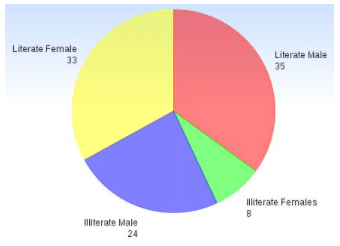UPSC Exam > UPSC Questions > The following pie-chart shows the percentage...
Start Learning for Free
The following pie-chart shows the percentage of literate and illiterate males and females in a city having a population of 2,50,000. What is the difference between the number of literate males and literate females?

- a)75,000
- b)1,500
- c)5,000
- d)500
- e)6000
Correct answer is option 'C'. Can you explain this answer?
Most Upvoted Answer
The following pie-chart shows the percentage of literate and illitera...
Difference between the number of literate males and literate females =87500−82500=5000
Hence, the correct option is (c).
Free Test
FREE
| Start Free Test |
Community Answer
The following pie-chart shows the percentage of literate and illitera...
100%=250000
2%=5000
2%=5000

|
Explore Courses for UPSC exam
|

|
Similar UPSC Doubts
The following pie-chart shows the percentage of literate and illiterate males and females in a city having a population of 2,50,000. What is the difference between the number of literate males and literate females?a)75,000b)1,500c)5,000d)500e)6000Correct answer is option 'C'. Can you explain this answer?
Question Description
The following pie-chart shows the percentage of literate and illiterate males and females in a city having a population of 2,50,000. What is the difference between the number of literate males and literate females?a)75,000b)1,500c)5,000d)500e)6000Correct answer is option 'C'. Can you explain this answer? for UPSC 2025 is part of UPSC preparation. The Question and answers have been prepared according to the UPSC exam syllabus. Information about The following pie-chart shows the percentage of literate and illiterate males and females in a city having a population of 2,50,000. What is the difference between the number of literate males and literate females?a)75,000b)1,500c)5,000d)500e)6000Correct answer is option 'C'. Can you explain this answer? covers all topics & solutions for UPSC 2025 Exam. Find important definitions, questions, meanings, examples, exercises and tests below for The following pie-chart shows the percentage of literate and illiterate males and females in a city having a population of 2,50,000. What is the difference between the number of literate males and literate females?a)75,000b)1,500c)5,000d)500e)6000Correct answer is option 'C'. Can you explain this answer?.
The following pie-chart shows the percentage of literate and illiterate males and females in a city having a population of 2,50,000. What is the difference between the number of literate males and literate females?a)75,000b)1,500c)5,000d)500e)6000Correct answer is option 'C'. Can you explain this answer? for UPSC 2025 is part of UPSC preparation. The Question and answers have been prepared according to the UPSC exam syllabus. Information about The following pie-chart shows the percentage of literate and illiterate males and females in a city having a population of 2,50,000. What is the difference between the number of literate males and literate females?a)75,000b)1,500c)5,000d)500e)6000Correct answer is option 'C'. Can you explain this answer? covers all topics & solutions for UPSC 2025 Exam. Find important definitions, questions, meanings, examples, exercises and tests below for The following pie-chart shows the percentage of literate and illiterate males and females in a city having a population of 2,50,000. What is the difference between the number of literate males and literate females?a)75,000b)1,500c)5,000d)500e)6000Correct answer is option 'C'. Can you explain this answer?.
Solutions for The following pie-chart shows the percentage of literate and illiterate males and females in a city having a population of 2,50,000. What is the difference between the number of literate males and literate females?a)75,000b)1,500c)5,000d)500e)6000Correct answer is option 'C'. Can you explain this answer? in English & in Hindi are available as part of our courses for UPSC.
Download more important topics, notes, lectures and mock test series for UPSC Exam by signing up for free.
Here you can find the meaning of The following pie-chart shows the percentage of literate and illiterate males and females in a city having a population of 2,50,000. What is the difference between the number of literate males and literate females?a)75,000b)1,500c)5,000d)500e)6000Correct answer is option 'C'. Can you explain this answer? defined & explained in the simplest way possible. Besides giving the explanation of
The following pie-chart shows the percentage of literate and illiterate males and females in a city having a population of 2,50,000. What is the difference between the number of literate males and literate females?a)75,000b)1,500c)5,000d)500e)6000Correct answer is option 'C'. Can you explain this answer?, a detailed solution for The following pie-chart shows the percentage of literate and illiterate males and females in a city having a population of 2,50,000. What is the difference between the number of literate males and literate females?a)75,000b)1,500c)5,000d)500e)6000Correct answer is option 'C'. Can you explain this answer? has been provided alongside types of The following pie-chart shows the percentage of literate and illiterate males and females in a city having a population of 2,50,000. What is the difference between the number of literate males and literate females?a)75,000b)1,500c)5,000d)500e)6000Correct answer is option 'C'. Can you explain this answer? theory, EduRev gives you an
ample number of questions to practice The following pie-chart shows the percentage of literate and illiterate males and females in a city having a population of 2,50,000. What is the difference between the number of literate males and literate females?a)75,000b)1,500c)5,000d)500e)6000Correct answer is option 'C'. Can you explain this answer? tests, examples and also practice UPSC tests.

|
Explore Courses for UPSC exam
|

|
Signup for Free!
Signup to see your scores go up within 7 days! Learn & Practice with 1000+ FREE Notes, Videos & Tests.


























